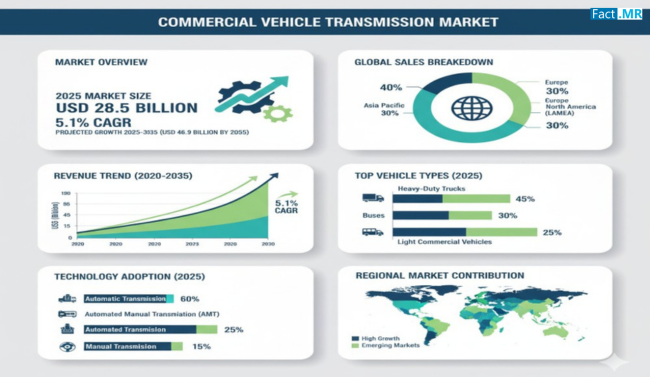As the global transportation industry evolves, the commercial vehicle transmission market is emerging as a key segment driving operational efficiency and vehicle performance. Transmission systems, which manage the transfer of power from the engine to the wheels, play a crucial role in optimizing fuel consumption, reducing emissions, and enhancing drivability in commercial vehicles.
The demand for efficient, durable, and technologically advanced transmission systems is increasing as fleet operators, logistics companies, and manufacturers seek solutions that improve performance while minimizing operational costs. With advancements in automatic, manual, and automated manual transmission technologies, the market is poised to redefine the commercial transportation landscape.
Market Overview
Commercial vehicle transmissions include manual, automatic, and automated manual systems, each designed to optimize vehicle performance and meet the specific needs of different commercial applications. Manual transmissions are valued for their simplicity, durability, and cost-effectiveness, particularly in heavy-duty trucks and buses. Automatic and automated systems are gaining popularity for their ability to enhance fuel efficiency, reduce driver fatigue, and improve overall vehicle performance.
Technological innovations are transforming the market, with features such as electronic control units, adaptive shift strategies, and integrated transmission management systems becoming standard. These advancements allow for real-time monitoring, improved gear-shifting efficiency, and reduced wear and tear, ensuring longer service life and lower maintenance costs.
The increasing focus on energy efficiency, regulatory compliance, and sustainable mobility is driving the adoption of advanced transmission systems in both new vehicles and retrofit applications.
Regional Insights
The adoption of commercial vehicle transmission technologies varies across regions due to differences in fleet composition, regulatory frameworks, and industrial infrastructure.
North America is a leading market due to its mature automotive industry, large fleet operations, and adoption of advanced technologies in logistics and freight transportation. Companies in the region are investing in automated and hybrid transmission systems to enhance efficiency, reduce operational costs, and comply with stringent emission regulations.
Europe is witnessing strong growth driven by regulations on emissions, fuel efficiency, and safety standards. European countries are prioritizing the integration of automatic and automated manual transmission systems in commercial vehicles to optimize fleet performance, reduce environmental impact, and support smart transportation initiatives.
Asia-Pacific is an emerging market fueled by rapid industrialization, urbanization, and increasing demand for commercial vehicles in logistics, construction, and public transport. Growing investment in automotive R&D, adoption of new transmission technologies, and supportive government policies are driving market expansion in the region.
Other regions, including Latin America and the Middle East & Africa, are gradually adopting advanced transmission systems, primarily in commercial fleets and public transport sectors, reflecting an increased focus on efficiency and sustainability.
Key Trends & Forecast
Several trends are shaping the commercial vehicle transmission market and its growth trajectory:
- Shift Toward Automatic and Automated Systems: Fleet operators are increasingly adopting automated and automatic transmissions for improved fuel efficiency, smoother operation, and reduced driver fatigue.
- Integration of Advanced Electronics: Modern transmissions are equipped with sensors, electronic control units, and telematics integration for real-time performance monitoring and predictive maintenance.
- Focus on Fuel Efficiency and Emission Reduction: Transmission technologies are being optimized to support eco-friendly vehicles, hybrid drivetrains, and alternative fuel-powered commercial vehicles.
- Lightweight and Durable Designs: Innovations in materials and engineering are producing transmissions that reduce vehicle weight while maintaining durability, contributing to overall efficiency and payload optimization.
- Collaboration Between OEMs and Tech Providers: Partnerships are enabling the development of next-generation transmission systems that incorporate AI-based control, adaptive shift patterns, and smart diagnostics.
- Expansion in Commercial Applications: Transmissions are increasingly being used in trucks, buses, vans, and specialty vehicles, reflecting their versatility across commercial vehicle segments.
These trends indicate a dynamic market focused on improving operational performance, reducing costs, and supporting sustainable commercial transportation.
Applications & End-Use Outlook
Commercial vehicle transmissions are applied across a variety of vehicle types and industries:
- Heavy-Duty Trucks: Transmission systems enhance fuel efficiency, optimize power delivery, and support long-haul logistics operations.
- Buses and Public Transport Vehicles: Advanced transmissions contribute to smooth operation, reduced fuel consumption, and lower emissions, improving passenger experience and operational efficiency.
- Delivery and Light Commercial Vehicles: Optimized transmissions help reduce operational costs, improve drivability, and support frequent stop-and-go driving conditions.
- Construction and Specialty Vehicles: Robust and durable transmissions are crucial for vehicles operating under heavy loads, challenging terrains, and demanding conditions.
- Fleet Management Solutions: Transmission technologies integrated with telematics allow fleet operators to monitor vehicle performance, optimize maintenance schedules, and enhance overall efficiency.
The diverse applications underscore the importance of commercial vehicle transmissions in improving efficiency, reliability, and sustainability across transportation sectors.
Conclusion
The commercial vehicle transmission market is transforming the way vehicles deliver performance, efficiency, and reliability. By integrating advanced technologies and innovative designs, transmission systems are helping fleet operators, logistics companies, and vehicle manufacturers reduce operational costs, enhance fuel efficiency, and meet stringent emission standards.
With ongoing advancements in automated, automatic, and hybrid transmission systems, the market is poised for continued growth as commercial vehicles evolve to meet the demands of modern transportation. Adoption of these systems is expected to accelerate globally, enabling cleaner, smarter, and more efficient commercial mobility.
Commercial vehicle transmissions are not merely mechanical components—they are critical enablers of operational efficiency, sustainability, and high-performance mobility in today’s fast-evolving transportation landscape.
Browse Full Report – https://www.factmr.com/report/commercial-vehicle-transmission-market



